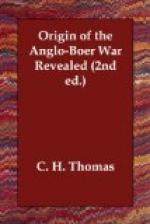[Footnote 6: Oil painting in the Amsterdam Exchange building representing Mercurius.]
AFRIKANER BOND—OUTLINES AND PROGRAMME
The late Mr. Jan Brand, that noble President who was succeeded by Reitz and now by Steyn in the presidency of the Orange Free State, appeared to have had early intimations, or at least presages, as to the true nature of the Afrikaner Bond, for during the early eighties that association had yet posed as a harmless body, intended to preserve old Boer traditions upon perfectly constitutional lines. President Brand and some others then already suspected more, as the following incident will show. In 1883 President Brand officially opened the new wagon-road bridge over the Caledon River at Commissie drift, near Smithfield, Orange Free State. Towards the conclusion of the ceremony, one of the other speakers, Mr. Advocate Peeters, member of the Volksraad for Smithfield district, in the course of his speech formally suggested that President Brand should accept the leadership of the Orange Free State section of the Afrikaner Bond. The President, addressing the burghers and all present, replied in about the following terms: The proposal just then made by Advocate Peeters had pained and offended him; the festive event would be marred by that incident were it not that it afforded him the opportunity, which he otherwise would have missed, of telling them all what he thought of the Afrikaner Bond—that it was an evil thing; he could not find terms strong enough to warn the people against its subtle seductions. The Afrikaner Bond professed its objects to be peace and harmony, but it really contained the pernicious seeds of division and strife, to set up enmity between English Afrikaners and Boer Afrikaners. He pointed out the sincerity of friendly relations on the part of England towards both the Orange Free State and the Transvaal Republics. The peace which restored to the Transvaal its independence a few years before was one big proof; his Government had many proofs of England’s good will, too. It suited both parties to maintain harmony—it behoved every Afrikaner to be one-minded in friendly reciprocation. Through a gracious Providence both Republics were prosperous and enjoyed independence. All over the world the prosperity of States depended upon good relations with their neighbours—this was especially so as regards the Orange Free State. They knew what kind of bond the Bible enjoined. It was the bond of peace and concord; and he concluded by declaring his well-grounded fears that the Afrikaner Bond was a device of the devil directed against the well-being of the entire Afrikaner nation. Instead of being encouraged, it should, like the “Boete Bosch"[7] (Xanthium spinosum, burr weed), be extirpated from the soil of South Africa.
MEMORANDA OF BOND PROGRAMME, EMANATING FROM HOLLAND (TRANSLATION FROM GLEANINGS).




